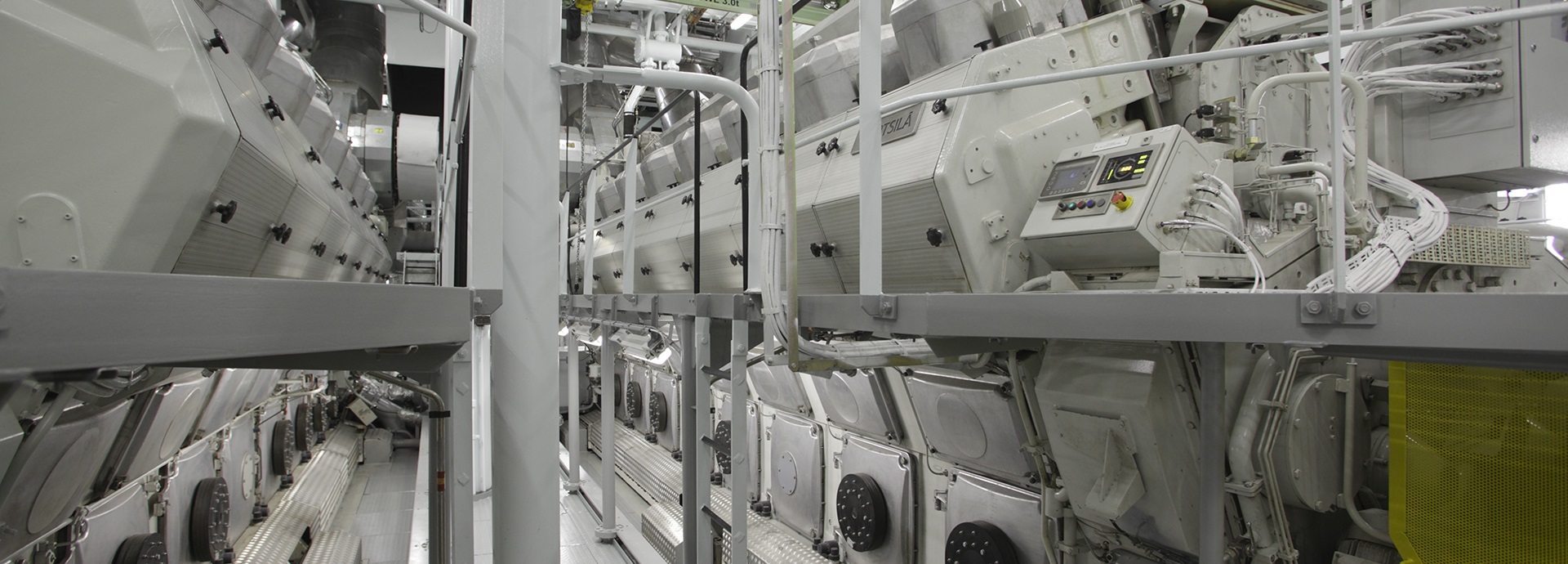

Two out of three ship fires start in the engine room – and most are caused by oil or other flammable liquids leaking onto hot surfaces. Beyond meeting the requirements of the International Convention for the Safety of Life at Sea (SOLAS), there is a lot you can do to protect people from the very real risk of an engine room fire.
Engine room fires are a constant concern in the maritime industry. According to a DNV article published in 2023, the incidence of engine room fires onboard container vessels increased sharply between 2019 and 2021 and had remained at the increased level by the time of the report. Fires present a major threat to the safety of the people onboard and can be harmful to the environment. Fires can also leave a vessel unable to operate for long periods as well as damage a shipping operator’s reputation and financial situation.
For example, the cost of a fire onboard a busy cruise vessel can have far-reaching consequences for the operator.
“On top of the very real risk to life, which is of course the number one concern, there is the financial cost and the cost of reputational damage. The cost of cancelling a cruise and taking a ship out of service because of a fire can easily run into tens of millions of dollars, even before you account for the actual repair costs.
The three most common causes of engine room fires are:
- Oil leaking onto hot surfaces
- Electrical faults
- Mechanical failures
Oil leaking onto hot surfaces is by far the biggest cause, accounting for more than 50% of all engine room fires. As the major cause, let’s focus on how to tackle this problem.
How do engine room fires start?
Engine components, exhaust pipes and other pieces of machinery typically operate at high temperatures, creating potential ignition points in an engine room. These hot surfaces can easily ignite flammable substances such as fuel oil, lubricant or hydraulic fluid that may have leaked or spilled during operations. High-pressure systems such as fuel injection or lubrication systems can also spray oil if a pipe, seal or fitting fails. This oil can ignite instantly if it comes into contact with a hot surface.
“You will never be able to completely prevent these kinds of leaks from happening, but you can reduce the risk of leaks causing a fire by implementing the mitigating actions required by SOLAS and class society rules.
There has been a lot of technological advancement in engine room safety-related solutions to support compliance with SOLAS chapter II-2. This chapter explains the regulations that your ship has to comply with in terms of fire protection, detection and extinction.
SOLAS states that engine surface temperatures must be kept below 220°C, but an increasing number of shipping operators are aiming to reduce these temperatures even further. For example, some cruise operators are aiming for a maximum surface temperature of 150°C. One of these is Royal Caribbean Cruises Ltd.
During 2016–2017 Royal Caribbean Cruises launched a project in collaboration with DNV and others. The target was to reduce the surface temperature of engine insulation boxes to 150°C. The ultimate goal of this project is to gain a voluntary class notation from DNV based on their rules for classification of ships, which is updated regularly.
How you can improve engine room safety
Insulation panels around ship engines are used as heat shields to minimise surface temperatures. These panels have a limited lifespan and need to be checked regularly and replaced if needed. Engine upgrades and other modifications can also affect the proper functioning of insulation solutions – if panels are not checked and adjusted after changes are made, they may no longer be fit for purpose.
With this in mind, let’s look at four main steps you can take to improve engine room safety:
- Perform an engine audit.
- Follow good maintenance practices and keep your engine room clean and tidy.
- Update your engine insulation when needed.
- Favour long-term solutions over short-term fixes.
1. Perform an engine audit
An engine audit inspects the current condition of the heat insulation solutions installed on your ship’s engines and helps you to identify possible improvements. The goal is to ensure your vessel meets or even exceeds the SOLAS requirements and the latest requirements of classification societies, flag administrations and port authorities.
There are two types of SOLAS audits that can be performed on your ship’s engines:
- Design-related inspection audits: These audits gather information for design purposes. The purpose is to build a clear picture of the status of the engine and existing insulation, and identify parts to be kept or replaced. These audits are also used to verify interfaces for any new insulation, the turbocharger outlet arrangement and the engine room layout. To ensure accurate project execution, 3D scanning services can be used to identify potential issues early in the design phase.
- Compliance audits: These audits ensure SOLAS compliance. Qualified experts perform hot spot measurements using infrared thermography (IRT) to inspect spray risk areas and hot surfaces prone to leakage or oil spills. The audit report includes thermal images, thermometer readings, findings, recommendations for corrective actions, and a copy of the calibration certificate for the measurement equipment used.
Royal Caribbean has a thermographic team that visits every ship at least once a year to audit the condition of the engine insulation boxes. This way, the company knows exactly what is happening and what repairs or modifications they might need to perform during a cruise liner’s next maintenance break.
2. Follow good maintenance practices and keep your engine room clean and tidy
Following good maintenance practices reduces the risk of fire. Over time, components such as fuel lines, oil seals and electrical systems can deteriorate – leading to leaks, overheating or short circuits. Regular inspections and timely repairs reduce the risk of these issues going unnoticed until a fire occurs. You should also check that oil piping connections are properly screened and replace any screens that were removed after repairs or maintenance work.
In terms of fire prevention, keeping your engine room clean, tidy and well maintained is a very effective first step. A clean engine room – where everything is in its right place and any litter, spills or other issues are attended to in a timely manner – is a far safer place to work, and the risk of fire is significantly reduced.
According to Heikkilä, a clean and tidy engine room is not only a safer engine room; it’s also a reflection of the crew’s pride and approach to how everything works on the vessel. He also highlights that a clean engine room makes maintenance easier, improves crew morale and, more importantly, makes it easier to identify any potential hazards like oil or other leaks.
3. Update your engine insulation when needed
A change in the engine design often means that you will need to adjust the insulation panels to ensure your vessel remains compliant with SOLAS regulations. For example, if you repair, upgrade or modify an engine there may be changes to things like the exhaust control system, the wastegate arrangement or the turbocharger washing system. An audit of the engine and its immediate surroundings will help you to identify how the insulation panelling needs to be updated or redesigned to accommodate these changes.
4. Favour long-term solutions over short-term fixes
An engine’s heat insulation panels are under constant thermal stress, which over time will alter the properties of the material. Short-term solutions like patching and repairing individual panels may be faster and less costly up front, but can lead to a never-ending game of catch-up. For example, some operators choose to use fire-retardant mattresses to cover hot spots in failing insulation panels, which can make the panel overheat, crack and eventually fail completely.
“Smaller defects or failures can also be a sign of bigger problems, so it is far better to take a holistic view with the help of a comprehensive audit and replace as much panelling as needed in one go.”
Jyrki Salo
Preparing for Port State Control inspections
Port State Control (PSC) inspections and focus campaigns are paying increasing attention to deficiencies in fire safety onboard ships. If you are notified by PSC about any deficiencies in your vessel’s engine heat insulation, you must take action.
Thomas Dirix, Principal Engineer, Machinery and MARPOL, DNV Maritime, gives three recommendations for owners and operators preparing for PSC inspections:
- Make sure there is regular maintenance – deficiencies recorded during PSC inspections are often due to a lack of maintenance. The relatively low cost of thermal imaging equipment makes it possible to include thermal imaging inspections by the crew as part of the regular maintenance routine, enabling early identification of problem areas.
- Ensure your crew is well trained – Port State Control officers will also use drills to assess whether the crew is properly trained on the available equipment and familiar with their duties. If your crew’s performance during a drill is deemed to be below the required standard, officers can impound the vessel.
- Know your vessel’s weak points – Knowing your vessel’s weak points will help you identify and solve problems early by making any necessary upgrades.
How Wärtsilä can help you reduce the risk of an engine room fire
Wärtsilä’s latest range of SOLAS solutions for 4-stroke engine can significantly reduce the risk of engine room fires.
- Wärtsilä offers maintenance sets, splash guard solution improvements and protection solution upgrades for hot surfaces.
- The number of components in heat insulation panel solutions is minimised in order to make installation as easy as possible, and panels are designed so that all engine maintenance points remain easily accessible.
- To reduce the risk of damage during installation or removal during maintenance, Wärtsilä panels are designed to be as rigid as possible while still being flexible enough to ensure easy installation.
- Wärtsilä heat insulation panels come with the same level of technical support and service as any other OEM part.
- All solutions are provided with comprehensive installation instructions.
- Wärtsilä offers SOLAS compliance audits, which can include an inspection using thermal scanning to evaluate the status of your engine insulation. If you plan to upgrade your engine insulation, Wärtsilä can perform an audit using 3D scanning. This audit identifies any factors in the engine room environment that may impact the installation of insulation panels. Wärtsilä experts can also attend on site during the installation process to provide support.
“As the OEM, Wärtsilä is the best place to turn for advice on maintaining and upgrading engine insulation on ships with Wärtsilä engines. They have the technical knowledge and they can test solutions before they are delivered to ensure the design is fit for purpose. Most importantly for us, every insulation solution we install is supported like any other spare part. If we need replacement panels it’s a quick process, and we can trust that the parts will fit properly and perform as expected.”
Kimmo Heikkilä
Learn how to protect your crews from the biggest cause of engine room fires with Wärtsilä’s SOLAS solutions for 4-stroke engine rooms.
The following experts provided valuable input for this article:
Kimmo Heikkilä, Associate Vice President, Marine Technical Systems, Royal Caribbean Group
Thomas Dirix, Principal Engineer, Machinery and MARPOL, DNV Maritime
Jyrki Salo, Senior Product Manager, Wärtsilä
Related solutions
Did you like this? Subscribe to Insights updates!
Once every six weeks, you will get the top picks – the latest and the greatest pieces – from this Insights channel by email.




